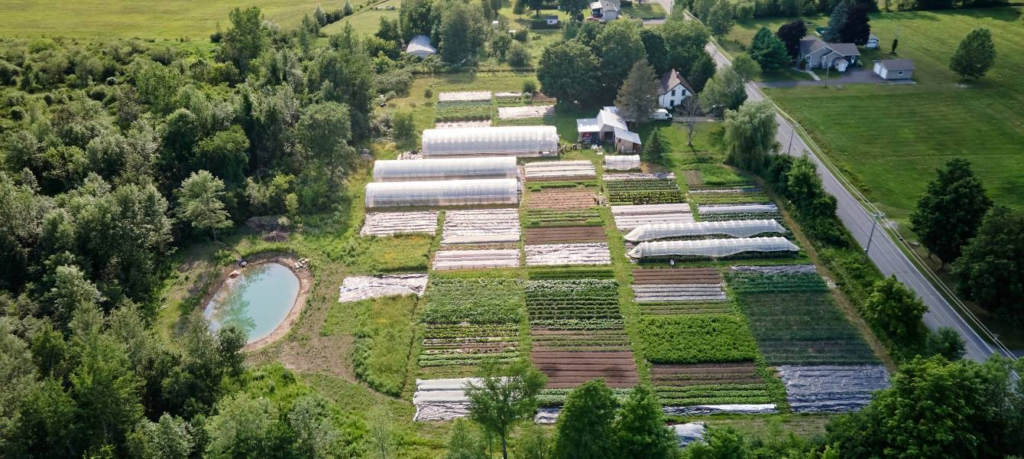
Market gardening is a great business idea for people looking to start a profitable venture that is both sustainable and environmentally friendly. This type of farming involves growing vegetables, fruits, herbs, and other crops that are sold directly to consumers at local farmers’ markets, grocery stores, and restaurants. In this article, we will discuss the steps you need to take to start a successful market gardening business.
Understanding market gardening
What is market gardening?
Market gardening is a type of small-scale farming that focuses on growing crops for sale directly to consumers in local markets. Unlike traditional farming methods that involve large fields and heavy machinery, market gardening uses smaller plots of land and hand-operated tools. This makes it a great option for people who want to start a farming business on a small scale.
Market gardening is also known as micro-farming or urban farming. It is a sustainable and environmentally friendly way of farming that promotes healthy eating and supports local communities. Market gardeners often use organic farming practices and avoid using harmful chemicals and pesticides.
Benefits of market gardening
There are several benefits to starting a market gardening business. Firstly, it allows you to grow crops that are healthy, nutritious, and free from harmful chemicals. By growing your own produce, you have control over the quality of your crops and can ensure that they are fresh and free from any harmful additives.
Secondly, market gardening provides a steady income source since there is a high demand for fresh, locally grown produce. Consumers are becoming more aware of the benefits of eating fresh, locally sourced produce, and are willing to pay a premium for it. This means that market gardeners can charge a higher price for their produce, which can lead to a more profitable business.
Additionally, market gardening is good for the environment as it promotes sustainable agriculture practices and reduces the carbon footprint associated with transporting food over long distances. By growing crops locally, market gardeners can reduce the amount of energy and resources required to transport food from the farm to the consumer.
Market gardening vs. traditional farming
One of the main differences between market gardening and traditional farming is the size of the land used to grow crops. While traditional farming relies on large plots of land, market gardening uses smaller plots that are more manageable and allow for higher yield per square foot. This means that market gardeners can grow more produce in a smaller area, which can lead to a more profitable business.
Another difference is the focus on crop diversity. Market gardening often involves growing a variety of crops that are sold directly to consumers, whereas traditional farming focuses on a few cash crops that are sold in bulk. Market gardeners can take advantage of the growing demand for specialty crops, such as heirloom tomatoes, exotic herbs, and gourmet mushrooms, which can command a higher price in the market.
Overall, market gardening is a great option for people who want to start a small-scale farming business that is sustainable, profitable, and environmentally friendly. By growing fresh, locally sourced produce, market gardeners can support their local communities and promote healthy eating habits.
Planning your market garden

Starting a market garden can be a rewarding and profitable venture. However, it requires careful planning and consideration. In this guide, we’ll take a closer look at the key steps involved in planning your market garden.
Setting your goals
The first step in planning your market garden is to set your goals. This involves deciding what you want to grow, where you want to sell your produce, and how much money you want to make. When setting your goals, it’s important to consider factors such as the local demand for certain crops, the competition in your area, and your own personal interests and strengths.
For example, if there is a high demand for organic vegetables in your area, you may want to focus on growing these types of crops. Alternatively, if you have a background in horticulture or a passion for growing flowers, you may want to consider specializing in cut flowers or ornamental plants.
Choosing the right location of your market garden
The location of your market garden is critical to its success. You need to choose a location that has fertile soil, access to water, and plenty of sunlight. Additionally, you need to consider factors such as local zoning laws, soil drainage, and potential sources of pollution that may affect the quality of your crops.
When selecting a location for your market garden, it’s important to think about the long-term viability of the site. You may want to consider factors such as the availability of nearby markets, transportation infrastructure, and the potential for expansion as your business grows.
Assessing your resources
Before you start your market gardening business, you need to assess your resources. This includes your financial resources, your skills and experience, and your available time. You also need to consider the tools and equipment you will need to start your business and whether you will be able to acquire them within your budget.
Starting a market garden can be a significant investment, and it’s important to be realistic about your financial resources. You may want to consider starting small and gradually expanding your business as you gain experience and build a customer base.
Creating a business plan for your market garden
Once you have a clear vision for your market gardening business, you need to create a business plan that outlines your objectives, strategies, and financial projections. This will help you stay organized and focused as you begin executing your plan.
Your business plan should include a detailed description of your products and services, your target market, your marketing and sales strategies, and your financial projections. It’s also important to include contingency plans for potential challenges or setbacks that may arise.
By following these key steps, you can create a solid foundation for your market gardening business and increase your chances of success.
Selecting your crops
Starting a market gardening business can be a rewarding and profitable venture. However, before you start selecting your crops, it is important to identify your target market. This will help you determine which crops are in demand and which ones are not.
Identifying your target market
If you plan to sell your produce at a local farmers’ market, you need to choose crops that are popular with consumers in your area. This will ensure that you are able to sell your produce quickly and at a good price. You can also consider selling your produce to local restaurants, grocery stores, or directly to consumers through a Community Supported Agriculture (CSA) program.
Researching crop demand
Once you have identified your target market, you need to research crop demand to find out which crops are most in demand. This will help you make informed decisions about which crops to grow and which ones to avoid. You can do this by talking to other farmers in your area, attending farmers’ markets and talking to consumers, and doing market research online.
Choosing profitable crops
In addition to crop demand, you need to consider the profitability of each crop. This involves looking at factors such as the cost of seeds and other inputs, the yield per acre, and the market price of each crop. By choosing crops that are both in high demand and profitable, you can maximize your income from your market gardening business.
Some profitable crops to consider include tomatoes, peppers, cucumbers, lettuce, and herbs. These crops are in high demand and can be sold at a good price.
Planning crop rotation in your market garden
Another important factor in selecting your crops is crop rotation. This involves growing different crops each year to help maintain soil health and prevent the buildup of pests and diseases. By rotating your crops, you can minimize the need for chemical fertilizers and pesticides, which will make your produce healthier and more environmentally friendly.
You can plan your crop rotation by dividing your garden into sections and rotating the crops in each section each year. For example, you can plant tomatoes and peppers in one section one year, and then plant lettuce and herbs in that section the next year.
Overall, selecting your crops is an important part of starting a successful market gardening business. By identifying your target market, researching crop demand, choosing profitable crops, and planning crop rotation, you can maximize your income and provide healthy, delicious produce to your customers.
Preparing your market garden
A market garden can be a great way to grow fresh produce and earn some extra income. However, to ensure the success of your garden, it is important to prepare the soil, manage water, set up garden beds, and implement pest control measures.
Soil preparation and testing
Healthy soil is essential for a thriving garden. Before you start planting, it is important to prepare your soil properly. This involves tilling the soil to loosen it up and adding compost or other organic matter to improve its texture and fertility.
It is also important to test the pH levels of your soil. Most vegetables prefer a pH level between 6.0 and 7.0. If your soil is too acidic or alkaline, you may need to adjust it by adding lime or sulfur.
Irrigation and water management
Water is another critical factor in the success of your market garden. You need to ensure that your crops receive sufficient water throughout the growing season, either through drip irrigation or other efficient watering methods.
One way to conserve water is to use a rain barrel to collect rainwater. This can be used to water your garden during dry spells, reducing your reliance on municipal water sources.
Additionally, you need to manage water runoff and ensure that your garden is not contributing to soil erosion. This can be accomplished by using mulch, planting cover crops, and avoiding over-tilling the soil.
Setting up garden beds
Once you have prepared your soil and irrigation systems, you need to set up your garden beds. Raised beds are a popular choice for market gardens, as they allow for efficient planting and harvesting and can be used to maximize space.
When setting up your garden beds, be sure to leave enough space between them to allow for easy access and maintenance. You may also want to consider using trellises or other supports for vining crops such as tomatoes and cucumbers.
Implementing pest control measures in your market garden
Pests can be a major problem for market gardens, as they can quickly destroy crops and reduce yields. To prevent damage to your crops, it is important to implement pest control measures.
One natural method of pest control is crop rotation. This involves planting different crops in the same area each year to prevent the buildup of pests and diseases. Companion planting is another natural method, where certain plants are grown together to repel pests or attract beneficial insects.
If natural methods are not effective, chemical pesticides may be used as a last resort. However, it is important to use these sparingly and according to the instructions on the label, as they can be harmful to both humans and the environment.
By following these steps, you can prepare your garden for a successful growing season and enjoy a bountiful harvest of fresh, healthy produce.
Conclusion
Starting a successful market gardening business requires careful planning, research, and execution. By following the steps outlined in this article, you can create a thriving and profitable market garden that provides healthy, fresh produce to your community while also promoting sustainable agriculture practices. Whether you are an experienced farmer or a complete novice, market gardening is a great option for anyone looking to start a home-based business that is both fulfilling and financially rewarding.



